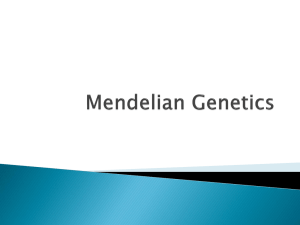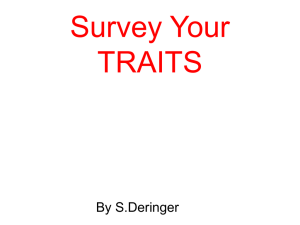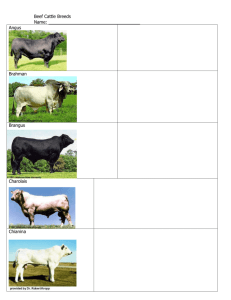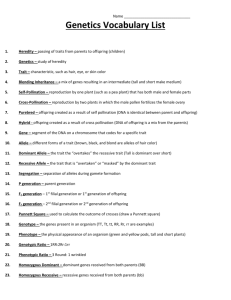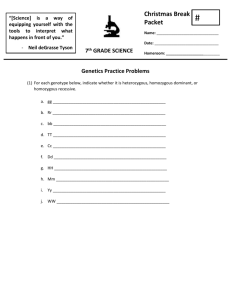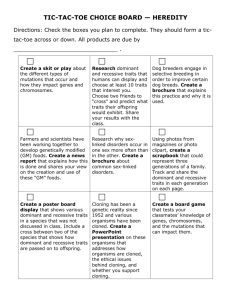Science 9 Unit 1: Biodiversity Name:
advertisement
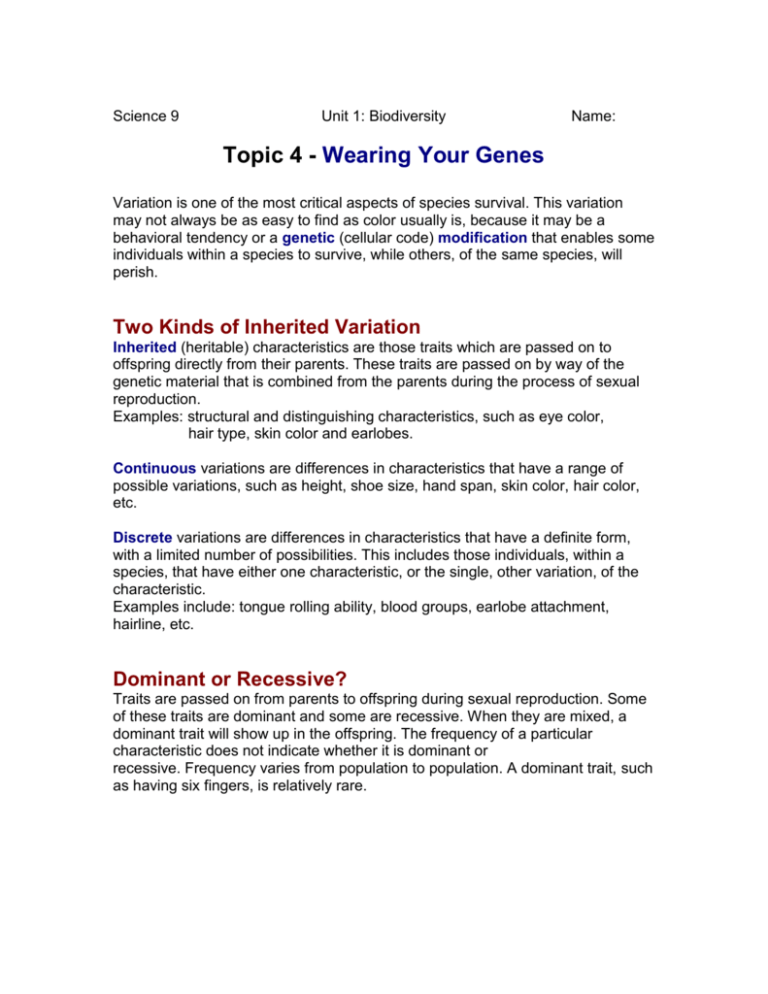
Science 9 Unit 1: Biodiversity Name: Topic 4 - Wearing Your Genes Variation is one of the most critical aspects of species survival. This variation may not always be as easy to find as color usually is, because it may be a behavioral tendency or a genetic (cellular code) modification that enables some individuals within a species to survive, while others, of the same species, will perish. Two Kinds of Inherited Variation Inherited (heritable) characteristics are those traits which are passed on to offspring directly from their parents. These traits are passed on by way of the genetic material that is combined from the parents during the process of sexual reproduction. Examples: structural and distinguishing characteristics, such as eye color, hair type, skin color and earlobes. Continuous variations are differences in characteristics that have a range of possible variations, such as height, shoe size, hand span, skin color, hair color, etc. Discrete variations are differences in characteristics that have a definite form, with a limited number of possibilities. This includes those individuals, within a species, that have either one characteristic, or the single, other variation, of the characteristic. Examples include: tongue rolling ability, blood groups, earlobe attachment, hairline, etc. Dominant or Recessive? Traits are passed on from parents to offspring during sexual reproduction. Some of these traits are dominant and some are recessive. When they are mixed, a dominant trait will show up in the offspring. The frequency of a particular characteristic does not indicate whether it is dominant or recessive. Frequency varies from population to population. A dominant trait, such as having six fingers, is relatively rare. Nature Versus Nature Not all characteristics are inherited. Some depend entirely on the environment. Non-inherited characteristics are acquired and not necessarily passed on from generation to generation. Athleticism, artistic ability, leadership qualities are all learned during the early years of life. Some variations may be influenced by interactions with the environment. These variations are also noninherited. Examples include: change in the pigmentation of skin color throughout the seasons due to the sun, height and weight can be influenced by diet. Scars, injuries, clothing, hairstyle, makeup, and cosmetic surgery may change a person’s characteristics, but they are not caused by genetics. The interactions between a person’s genetics and the environment are very complex and are constantly being debated. One way that scientists study the relationship between genetics and the environment is to observe the similarities and differences between identical twins that have been separated at birth and raised in different environments. Changing Our Genetic Information Factors in the environment, or random events can change genetic information contained in DNA. These changes are called mutations, and can cause changes in the structure of organisms, including people. Mutagens, such as X-rays, ultraviolet rays, cosmic rays and some chemicals can cause mutations to occur – some that have little visible effects and some that have dramatic effects. Some mutations can cause cancer, which promote rapid cell division and impair full formal cell development. The cancerous cells can interfere with other cells and prevent certain processes from occurring as they should. If mutations occur in the DNA of reproductive cells, the changes can be passed on from the parent to the offspring, increasing the variation within a species. Genetics Two terms used to describe traits you inherit from your parents: Phenotype- the way the trait actually appears, functions, or behaves. Ex: Tall, short, eye color Genotype- the gene combination found in the organisms chromosomes. Ex: TT, Tt, tt Dominant Genes – a gene that will always appear even if it is paired with a gene for the opposite trait. (show up) Ex. T = dominant for tall t = short Tt = tall Recessive Genes – a gene that does not appear if paired with a gene for the opposite trait. (hidden) *- it will appear if it is paired with another gene like itself. Ex: T = dominant t = recessive Tt = tall t= recessive t= recessive tt = short Homozygous or Pure - individuals who have two genes that are the same for a characteristic. Ex: TT or tt Heterozygous or Hybrid- individuals who have two different genes for a given characteristic. Ex: Tt or tT A diagram called a Punnett Square can be used to predict the possible genotypes of offspring. ( Only if the genotypes of the two parents are known.) Process Notes for Punnett Square: 1. Find out which trait is dominant Green= dominant yellow = recessive 2. Assign letters to the traits Green = G Yellow = g 3. Decide if the letter GG and gg (pure) combinations are pure or hybrid 4. Write parental genotypes G G around square. g g 5. Find possible offspring g g 6. Find offspring genotypes G Gg Gg G Gg Gg Genotype = Gg 100% 7. Find the offsprings Phenotype = Green 100% phenotype 8. Write the percentage of Same as #’s 6 & 7… phenotypes in the Gg 100% offspring. Green 100% Example: Hetrozygous (hybrid) smooth X Heterozygous (hybrid) smooth Ss X Ss S s S SS Ss Genotype = 50% Ss , 25% SS, 25% ss s Ss ss Phenotype = 75% Smooth, 25% wrinkled Topic 4 Assignment Vocabulary: Genetics - Continuous Variation - Discrete variation - Dominant - Recessive - Mutations - Mutagens - Punnett Square - I. Complete the topic 4 review questions on p. 45 #1-6 II. Punnett Square Questions: a. Cross a hybrid tall pea plant with a pure short pea plant. (Tall is dominant and short is recessive) b. A pure black cat mated with a pure white cat. Show the offspring. (Black is dominant and white is recessive)


